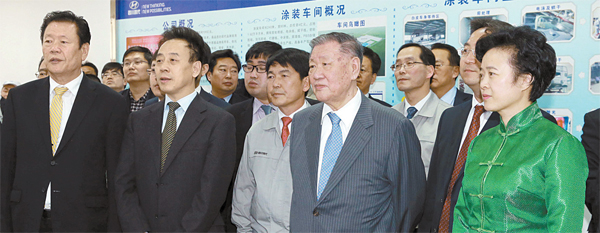Hyundai to build fourth auto factory in China

Hyundai Motor Group Chairman Chung Mong-koo, second from right, tours a commercial vehicle manufacturing facility that is to be completed in the first half of this year in Sichuan Province, China, yesterday. Provided by the company
The plan to build a factory in the southwestern city of Chongqing will be officially announced today when Chung Mong-koo, chairman of Hyundai Motor Group, signs a preliminary agreement with the city government. Chung left for China yesterday.
The agreement is not yet final.
“We would say the actual deal is certain to be made,” said an official from Hyundai Motor. “It’s just that there are some administrative procedures left such as receiving approval from the central government of China.”
China is one of the biggest overseas markets for Hyundai Motor. Since entering the market in 2002, it has grown large enough to hope to sell 10 million units this year, including both Hyundai brands and those of Kia, its smaller subsidiary. The automaker forecasts that annual demand in the Chinese passenger car market will reach as high as 20.1 million units in 2016 when the Chongqing plant is completed and starts churning out vehicles.
Most of the sales are imported cars. In China, Hyundai Motor has a total manufacturing capacity of 1.05 million units per year. Kia Motors can produce an additional 740,000 units in China.
According to the company, the Chongqing plant will be able to create a total of 300,000 units per year, bringing the group’s total production in China up to 2.3 million units per year starting in 2016, including Kia’s production and commercial vehicle production.
The increase in capacity is expected to boost Hyundai Motor Group’s competitiveness in the Chinese passenger car market, which is dominated by foreign automakers like Volkswagen, General Motors and Nissan. Volkswagen has the capacity to manufacture 4.2 million units a year in China, while GM is able to produce 3.8 million units. Nissan can make 1.7 million units.
Chongqing was chosen by Hyundai because of growth in the region.
The city is the largest of the four cities that are directly controlled by China’s central government. Chongqing recorded annual regional GDP growth rate of 12.3 percent last year, faster than the country’s 7.7 percent average. Beijing’s GDP growth rate in 2013 was 8 percent.
Hyundai Motor also decided to turn to western China as its three other production facilities are all in Beijing. Kia Motors’ three plants are located in Yancheng in eastern China.
Hyundai Motor is also building a commercial vehicle factory in Sichuan Province to be completed this year.
The Chinese government has been trying to attract foreign investment to its western regions for years by lifting taxes and expediting licenses. In Chongqing there are already auto manufacturing plants run by foreign automakers including Ford, Suzuki and GM.
Hyundai Motor also projects the commercial vehicle market to grow in the western part of the country, with demand rising to 4.2 million units this year and 5.3 million units in 2020.
“With mass development projects in mid and western China, the commercial vehicle market is growing fast,” said Chairman Chung.
BY KIM JI-YOON [jiyoon.kim@joongang.co.kr]










with the Korea JoongAng Daily
To write comments, please log in to one of the accounts.
Standards Board Policy (0/250자)